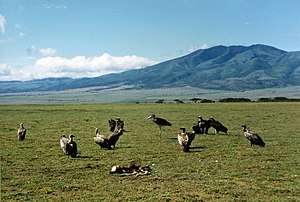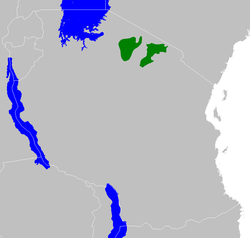Serengeti volcanic grasslands
The Serengeti volcanic grasslands is a tropical grassland ecoregion of Tanzania. The Serengeti volcanic grasslands are distinctive grasslands growing on deposits of volcanic ash in northern Tanzania. It includes the eastern portion of Serengeti National Park and areas south and east of the Ngorongoro Highlands.[1]
| Serengeti volcanic grasslands | |
|---|---|
 Vultures in Serengeti National Park | |
 Map of Serengeti volcanic grasslands ecoregion | |
| Ecology | |
| Realm | Afrotropic |
| Biome | Tropical and subtropical grasslands, savannas, and shrublands |
| Geography | |
| Area | 17,900 km2 (6,900 sq mi) |
| Country | Tanzania |
| Conservation | |
| Conservation status | vulnerable |
Geology
The Serengeti volcanic grasslands are an edaphic plant community that grows on soils derived from volcanic ash. The eruption of the now-extinct Kerimasi volcano 150,000 years ago deposited huge amounts of fine whitish-grey ash. More recent eruptions of the Ol Doinyo Lengai volcano deepened the ash deposits. These ash deposits hardened with time, creating layers of calcareous tuff and calcitic hard-pan soil.[2] The flat or slightly undulating plains are interrupted here and there by rocky kopjes, outcrops of the underlying Precambrian rocks.[3]
Flora
Characteristic grass species include Andropogon greenwayi, Chloris gayana (Rhodes grass), Cynodon dactylon (Bermuda grass), Digitaria macroblephara, Eragrostis tenuifolia (Elastic grass), Eustachys paspaloides (Fan grass), Microchloa kunthii (Kunth's smallgrass), Panicum coloratum (Coloured Guinea grass), Pennisetum mezianum, Pennisetum stramineum, Sporobolus ioclados (Pan dropseed), and Themeda triandra (Red grass).[4]
References
- "Serengeti volcanic grasslands". WWF ecoregion profile. Accessed 24 September 2019.
- Kindt, R., Lillesø, J.-P. B., van Breugel, P., Bingham, M., Sebsebe Demissew, Dudley, C., Friis, I., Gachathi, F., Kalema, J., Mbago, F., Minani, V., Moshi, H. N., Mulumba, J., Namaganda, M., Ndangalasi, H.J., Ruffo, C.K., Jamnadass, R. and Graudal, L. 2011. Potential natural vegetation of eastern Africa. Volume 5: Description and tree species composition for other potential natural vegetation types. Forest & Landscape Working Paper 65-2011
- "Serengeti volcanic grasslands". WWF ecoregion profile. Accessed 24 September 2019.
- Kindt, R., Lillesø, J.-P. B., van Breugel, P., Bingham, M., Sebsebe Demissew, Dudley, C., Friis, I., Gachathi, F., Kalema, J., Mbago, F., Minani, V., Moshi, H. N., Mulumba, J., Namaganda, M., Ndangalasi, H.J., Ruffo, C.K., Jamnadass, R. and Graudal, L. 2011. Potential natural vegetation of eastern Africa. Volume 5: Description and tree species composition for other potential natural vegetation types. Forest & Landscape Working Paper 65-2011